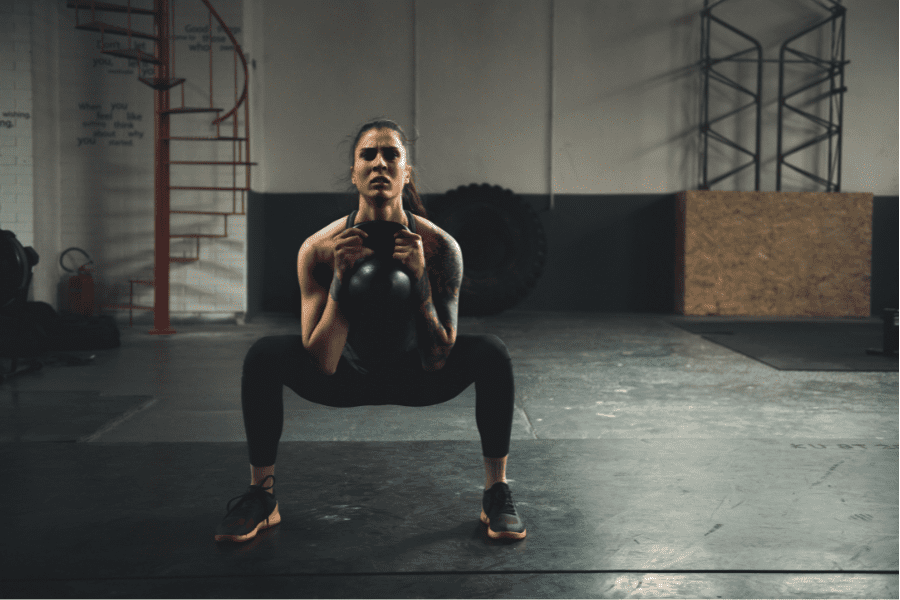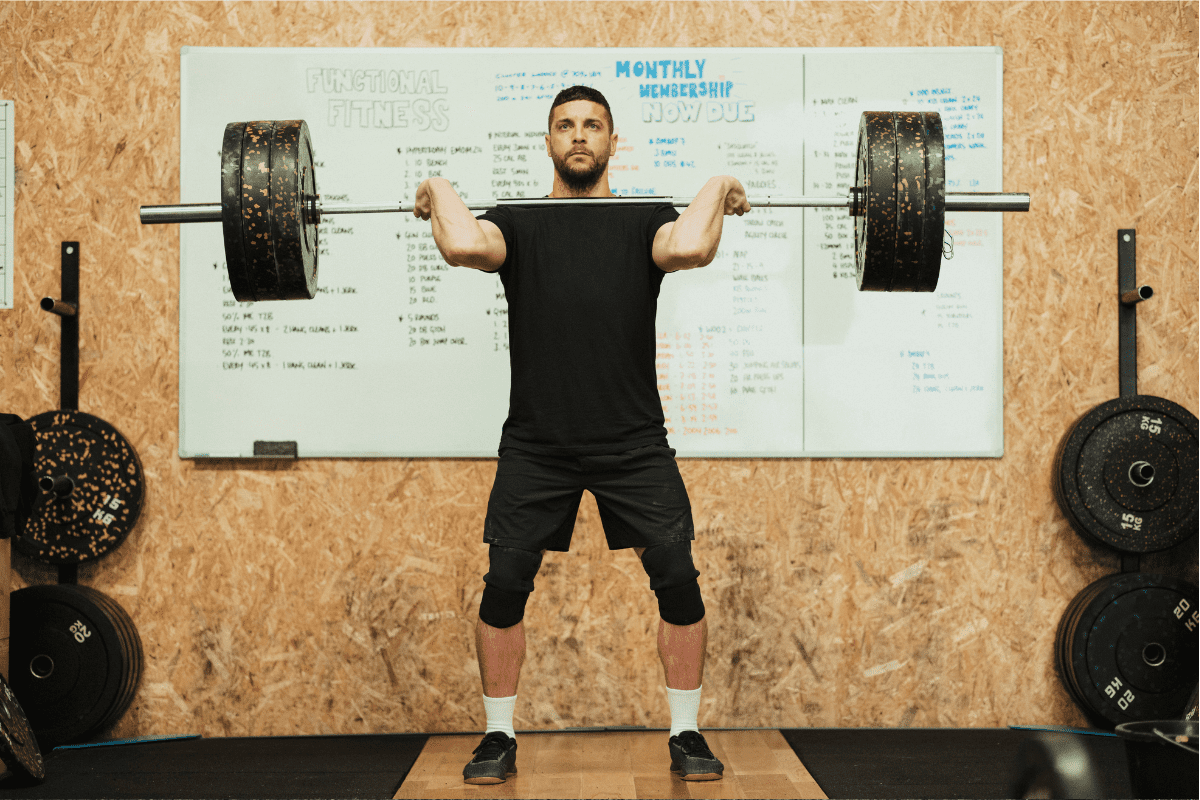Front Squat (How To, Muscles Worked, Benefits)
The Front Squat is one of the most fundamental lifts for athletic performance. Front Squats are used by strength and conditioning specialists, sports medicine professionals, physical therapists, and the general public primarily to increase strength but also to benefit power and hypertrophy development.
Traditionally, the Front squat has been used in training for athletes in Olympic lifting, powerlifting, and strongman training, but its variability has proven to be useful for field and court athletes (Football, Baseball, Basketball, and more).
Because the Front squat trains the athlete to produce more force, the athlete will benefit from an increased rate of force development, showing greater power outputs.
In this guide, I am going to explain how to properly Front squat, the muscles worked, and also give some good variations and alternatives.
How To Front Squat
Equipment Needed
- Squat Rack
- Barbell
- Bumper or Iron Plates
- Lifting Straps (optional if needed)
Step-by-Step Instruction
- Set the height of the squat rack so that the barbell is about 1-2 inches below the flexed elbow (Elbow pointing toward the squat rack prior to taking the weight off the hooks).
- One of the first considerations you are going to want to make is what grip you want to use to perform the front squat.
- Later in the article, I will talk about different grips and the reasoning behind each grip.
- For now, I am going to assume you are using a two-finger clean grip. (Most commonly used by athletes).
- Walk closely to the barbell and place it very close to your neck.
- Bring your elbows up and the barbell should be resting on the raised anterior deltoid muscles. You are now holding the bar with what’s called a “front rack position” (THERE SHOULD BE NO STRESS OR TENSION ON THE HAND OR WRIST TO HOLD THE BARBELL).
- With your front rack, lift the bar off the hooks. I recommend a staggered stance to lift the barbell off the rack.
- Take 2 steps back and set your feet slightly wider than shoulder width. Toes slightly pointed out.
- Maintaining a strong front rack, take a deep breath, and brace the core.
- Initiate the squat by hinging the hips back and bending the knees simultaneously.
- Descend into the squat with control until your hip crease is slightly below the knee. (Most professionals consider this to be parallel or just below parallel).
- At this point, the core should be braced, the front rack strong, elbows up, and the lifter is ready to drive out of the “hole” and stand the weight back up.
- Keep a balanced foot with a strong arch, drive through the heels, and drive the hips until you are back at the top of the movement and ready for the next rep.
Grips
- Clean grip with 1 or 2 fingers. This is the most common grip used by Olympic lifters and athletes. This trains the specific position the bar would be in at the catch of a clean and therefore very advantageous for these athletes.
- Crossed arms. This is a common grip for athletes that want all the benefits from the front squat but may not have the flexibility or need for a finger grip.
- Lifting Straps. This allows the lifter to get the front rack position, engaging the upper back musculature, and takes a lot of stress off the fingers and wrists.
Coaching Points
By far the most common mistake with Front squatting (and most all compound movements) is improper form. Because the lift is very technical, uses the whole body, and requires patience and persistence, lifters oftentimes have incorrect form without realizing it, go up in weight too quickly, and may injure themselves.
Be patient with your flexibility. Persistence and working hard on your flexibility will pay off with front squatting. Remember to always warm up prior to any lifting session. Work on flexibility drills during warm-up sets as well. After your session, use cool-down techniques, foam roll, stretch, and hydrate.
Technical tips:
- Video your sets and reps
- Have an experienced lifter/trainer watch your sets and reps
- In regards to your setup and form; treat every rep like it’s a 1 rep max
- Put a tremendous amount of detail in your setup (Do it the exact same way, every rep)
- Make small gains in weight over time.
Benefits
Front squats are a variation of the traditional back squat exercise. They have many of the same benefits, including building strength and power in the lower body and improving balance and coordination.
However, Front Squats have some additional benefits compared to back squats. Because the barbell is held in front of the body, front squats engage the core muscles more, helping to improve core stability and posture.
Front Squats can also help to improve mobility in the hips, ankles, and wrists.
Muscles Worked
- Hamstrings
- Glutes
- Quadriceps
- Upper Back
- Lower Back
- Shoulders (Stability from holding the barbell in the front rack)
Front Squat Variations
Paused Front Squats
Perform the front squat and pause in the hole with the weight for 1-3 seconds (Number of seconds based on training program, periodization, and athlete readiness).
Pin Front Squats
Perform the front squat from a pre-determined starting position height (Height based on training program, periodization, sticking point weaknesses, and athlete readiness)
Safety Bar Squats
Perform the squat exactly as you would for a front or back squat. The safety bar is a unique implement that isn’t exactly like back squatting or front squatting. This implement is great for lifters that want to benefit from squatting but may have a hand injury or struggle with upper-body flexibility.
Front Squat Alternatives
Need an alternative for Front Squats? Here are a couple of exercises you may be able to use as a replacement.
Need more options? Here are 10 of my favorite Front Squat alternatives to develop lower-body strength.
Belt Squat
This requires a belt squat machine. If you have access, this is a great alternative for a lifter that has back pain issues, upper body flexibility issues, or upper body injuries that disallow barbell use.
Goblet Squats

Holding the kettlebell in the front rack (By the horns of the kettlebell) perform the squat pattern. Goblet Squats is a great option for novice lifters learning to squat and perfect their form.
DB Split Squat
Holding dumbbells in both hands, split your feet so that the front foot can stay flat as you squat and the back foot comes up on the toe. Keeping an upright torso, shoulder blades back, and core right, squat down, pause, and drive back up to the start.
This is another great option for a novice lifter looking to gain strength and hypertrophy on a single leg. This is also a great option for an experienced lifter who wants to train a single leg movement and add some volume at the end of a session.
Risks
I would be doing the reader a disservice without discussing the potential risks of traditional barbell squatting. This lift is highly technical and requires a tremendous amount of attention to detail, practice, and a slow gradual increase in weight. An athlete who does not consistently set up the right way and sacrifices form to lift more weight will get hurt.
It is also important to consider rest, recovery, and balancing other life activities.
Because the front squat stresses the entire body and is very hard on the central nervous system, it takes time to recover from a serious front squat session. Field and court athletes should consider what day of the week they are squatting.
If you are going to squat heavy on a particular day of the week, it is not recommended you do any other heavy lower-body lifting, sprinting, or serious competition, until fully recovered. Training history, readiness, and history of injury all need to be considered.
As an athlete, it is important to make sure the lifting in the weight room is correlating and in conjunction with your sport. Rest and recovery are absolutely critical to reap the benefits of any lift and should be taken seriously by all athletes.
More Links and Info
Head over to our Exercise Library to find more Lower Body Lifts, all complete with step-by-step instructions.

